Tetkol
Тетяна Колесник
Леся Українка
Why does my toddler love repetition? - BabyCentre UK. Paediatric speech and language therapist It may test your patience when your toddler demands 'Row, row, row your boat' for the 10th time.
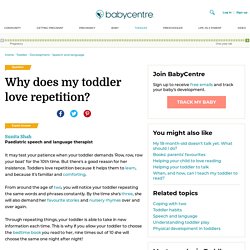
But there's a good reason for her insistence. Toddlers love repetition because it helps them to learn, and because it's familiar and comforting. From around the age of two, you will notice your toddler repeating the same words and phrases constantly. By the time she's three, she will also demand her favourite stories and nursery rhymes over and over again. Through repeating things, your toddler is able to take in new information each time. And she will love stories and nursery rhymes with repeated phrases, because she can join in. A small study has found that repetition of stories may help children to learn new words. After hearing her favourite book many times, your toddler may even remember it well enough to add the endings to some of the sentences.
Moodle. Moodle. To Help Children Learn, Build on What They Already Know - RAISE READY KIDS. In his brilliant children’s book Fish Is Fish, Leo Lionni tells the story of a fish and tadpole who become best friends.
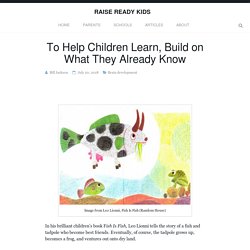
Eventually, of course, the tadpole grows up, becomes a frog, and ventures out onto dry land. One day, the frog jumps back into the pond to see his old friend the fish. “I have seen extraordinary things!” The frog exclaims.
Assessment for Learning – Education in New Zealand. Observation, Assessment and Planning - Early Years Matters. The EYFS Profile summarises and describes children’s attainment at the end of the EYFS.
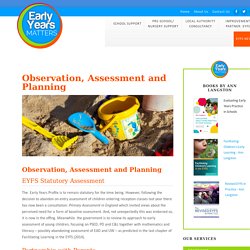
It is based on on-going observation and assessment in the three prime and four specific areas of learning, and the three learning characteristics, set out below: The prime areas of learning:
Early Learning for Every Child Today. A framework for Ontario early childhood settings. Information_sheet_-_Guidelines_for_documenting_children_s_learning. Pre-birth to Three: Observation, Assessment and Planning.
Let’s lose the ADHD label and find the child. When I trained as a primary school teacher 15 years ago, these were some of the words used to describe children with ADHD: ‘Difficult.’

‘Challenging.’ ‘Disruptive.’ There were others, whispered by harassed-looking teachers in the staffroom or concerned parents at the school gates, but none seemed to be positive. When I got my first ‘real’ class to teach, and saw that some of the children came with the dreaded ‘ADHD’ label attached, I approached the new term with butterflies the size of dragons in my stomach.
Development-Matters-FINAL-PRINT-AMENDED.
This ‘Kindness Curriculum’ Is Free And Should Be Used In Every Classroom. Imagine living in a world that valued kindness enough to teach it along with academics. Educators would teach kids to manage their emotions in addition to standard curriculum such as math and science. Sounds pretty amazing, doesn’t it? Well, the Center for Healthy Minds at the University of Wisconsin-Madison has created a free “kindness curriculum” for kids, designed to do just that.
A 19-Year Study Reveals Kindergarten Students With These 2 Skills Are Twice as Likely to Obtain a College Degree (and They Have Nothing to Do With Reading)
One theory all teachers with disruptive children should know about. Imagine a classroom where children are unable to wait their turn or stay focused on their work.
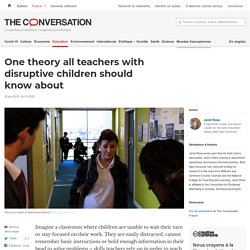
They are easily distracted, cannot remember basic instructions or hold enough information in their head to solve problems – skills teachers rely on in order to teach successfully. These behavioural issues are all examples of problems that can arise from attachment issues – based on the relationship between children and their main caregiver. Attachment theory is now one of the world’s most well-researched theories about human development. It was first proposed by the 20th-century British psychiatrist John Bowlby, who considered that children needed to develop a secure attachment with their main caregiver via sufficiently consistent, responsive, sensitive, appropriate and predictable care and support.
Don't Expect Toddlers To Behave Consistently — They Literally Can't. One day, when my oldest daughter was not quite 2, she wouldn’t sit still to let me change her diaper.
Squirrelly and writhing, she made a game out of staying half naked. She wasn’t fussing about it or anything — in fact, she was giggling maniacally. The problem was that we were running late. Nothing I did seemed to faze her.
Can Free Play Prevent Depression and Anxiety In Kids?
Positive Learning Environment - Primary. Background_to_the_Concept_of_Schema. EducatorsEn.
NQS_PLP_E-Newsletter_No36. Key Person & Attachment - Early Years Matters. The Key Person Children thrive from a base of loving and secure relationships.

This is normally provided by a child’s parents but it can also be provided by a key person.
How Are Happiness and Learning Connected?
As teachers, we also know that when students' affective filters or defenses are sky high, fight or flight responses will be modus operandi. A room full of defensive behaviors (withdrawn, angry) is a sad, unproductive place to teach and learn. Now let's flip it and take a look at how much more we are able to learn when we are in harmony with the people and things in any given educational environment.
Being in harmony means feeling safe, feeling valued and a necessary part a group, and in this case, a learning community. Hearts and Minds in Sync What does research show to be the opposite of the brain's fight or flight response?
Guiding Principles for Use of Technology with Early Learners. The thoughtful use of technology by parents and early educators can engage children in key skills such as play, self-expression, and computational thinking which will support later success across all academic disciplines and help maintain young children’s natural curiosity.
The Departments recognize that families and early educators have many different options for using technology with early learners. The Departments believe that guidance needs to reflect the reality that families and early educators have access to apps, digital books, games, video chatting software, and a multitude of other interactive technologies that can be used with young children. Even as new technologies emerge, the Departments believe that these principles apply, though guidance may evolve as more research on this topic is published. The Departments’ four guiding principles for use of technology with early learners are as follows: Guiding Principle #1:
Schemas in Children’s Play - N A T U R E P L A Y. Written by Clare CaroSchemas in Children’s Play are such an important concept when it comes to the development of our children that it’s worth taking the time to understand them so you can facilitate them when you see them.What are these schemas?

Well it’s really a fancy word for the urges that children have to do things like climb, throw things and hide in small places. They appear through play; perhaps it is the way they choose to do things, or what they desperately need to do out of the blue! Bringing It All TogetherAfter looking at each schema individually to get to grips with what each 'urge' is all about we may already be able to recognise some of the different ways they can appear in your child.Rotation, Trajectory, Enveloping, Orientation, Positioning, Connection, Enclosure/Container, Transporting and Transformation are urges that show in all children starting as early as their first birthday, some times before.How Can Knowing About These Urges Help Us?
Does my toddler have a short attention span because she won’t sit still for a story?
A: It is perfectly normal for toddlers to not sit still very long—period.
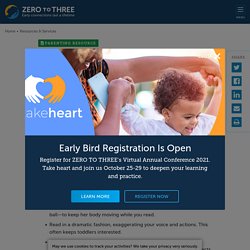
Most don’t like to stay in one place for long now that they can explore in so many new ways—by running, jumping, and climbing. So, an adult’s idea of snuggling on the couch to hear a story may not be the same idea a toddler has for story-time.
Primary Plus – English for kids aged 6-12. During the Covid-19 pandemic many of our teaching centres are closed. Classes will continue online and our teachers look forward to bringing their passion and expertise into your home. Primary Plus, developed by our team of English experts, will spark your child’s imagination, so they can express themselves with confidence that goes beyond their English language skills. Our new approach means your child will have a more rewarding learning experience, getting the most out of learning English at home with a combination of: live online classes with a specialist teacherinteractive independent study, set by your child's teacher to prepare them for the live lesson – all in a safe, easy-to-use learning environment.
Making their mark children's early writing. Whole Child Development Is Undervalued. The question is how to make such an approach both systemic and sustainable. Whole Person Socio-emotional, physical, creative, and cognitive capacities are deeply intertwined and equally important in ensuring a child's wellbeing, learning, and growth.
LearnEnglish Kids - British Council. Nursery Rhymes and Songs - BBC Teach. Music and Movement Activities for Toddlers and Preschoolers. 50+ Quick & Easy Kids Crafts that ANYONE Can Make!
Feelings are feelings. How to teach children English using illustrated storybooks. What makes illustrated storybooks such a good resource for teaching young learners of English? The British Council’s Gail Ellis, co-author of a storytelling handbook for primary English language teachers, explains. Listen to an interview with Gail in our podcast and register for her webinar taking place on Thursday, 2 October.
Children-under-5-walking. Children-under-5-years. Nihms175063. Ey_making_mark_matters76708_1_
The Art of Control. Executive function — our ability to remember and use what we know, defeat our unproductive impulses, and switch gears and adjust to new demands — is increasingly understood as a key element not just of learning but of lifelong success.
Researchers at the Center on the Developing Child at Harvard University describe executive function as an air traffic control system for the mind — helping us manage streams of information, revise plans, stay organized, filter out distractions, cope with stress, and make healthy decisions.
How to help your child learn English with YouTube videos. Tracey Chapelton, education consultant and materials writer, has some advice for parents of young English learners, whose home language might not be English.
Practical tips. Quality Interactions Early Years.
Moodle. Moodle. Moodle. Moodle. Moodle. Serve and Return. Effective Teacher-Child Interactions. The Brain-Changing Power of Conversation. The Science Researchers used highly faithful audio recorders — a system called Language Environment Analysis (known as LENA) — to capture every word spoken or heard by 36 4–6 year olds from various socioeconomic backgrounds over two full days. The recordings were analyzed to measure the number of words spoken by each child, the number of words spoken to each child, and the number of conversational turns — back-and-forth exchanges initiated by either adult or child. Comparing those measurements with brain scans of the individual children, the analysis found that differences in the number of conversational turns accounted for differences in brain physiology, as well as for differences in language skills including vocabulary, grammar, and verbal reasoning.
Read the MIT News story for a fuller summary of the research. The Takeaways The “conversational turns” are key here, the researchers say.
MIT Brain Study: Back-And-Forth Talk Key To Developing Kids' Verbal Skills. NQS_PLP_E-Newsletter_No43. Carol Dweck: The power of believing that you can improve. How can parents and teachers best educate young children?
Listening Skills for Staff. A longitudinal investigation of the role of quantity and quality of child-directed speech in vocabulary development. Moodle. Inclusion Development Programme - Supporting children with Behavioural, Emotional and Social Difficulties:
NO MORE CHALLENGING BEHAVIOR CHEAT SHEET. FAQ: Raising Bilingual Children.
Why want bilingual children? There are many reasons, but the two most common are: 1) The parents speak different languages (say, an American woman and a Turkish man). 2) The parents speak the same language, but live in a community where most people speak something else (say, a Korean couple living in the USA).
B480 Special Need Publication A4 V5 Final MR. Teaching English to learners with Special Educational Needs (SENs) – Myths and realities. ‘I know I have children with special educational needs in my class, I want to help them and we are supposed to promote inclusion, but I really am not sure how to do this’ Vera, primary teacher from Spain.
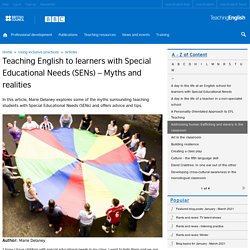
Does my toddler have a short attention span because she won’t sit still for a story?
Early Years Training and Coaching. Schemas are one of those things that divide practitioners, like fairies at the bottom of the garden.
Schemas in Children’s Play - N A T U R E P L A Y. "I Said I Want the Red Bowl!" Responding to…
2Bbellybreathhome. Deconstructing Role Play – Provide the Resources, Step Back and Watch Children’s Learning Flourish.
Symbolic play and language development. NPR Cookie Consent and Choices. The cognitive benefits of play: Effects on the learning brain. Low-cost play ideas & materials. Primary school shake-up to focus on ‘play-led’ learning. Why Movement is Essential in Early Childhood. Play to Learn: Discussion.
Play to Learn. Learning_through_play_ey. Pts-why-play-is-important. Play-based-learning_statement_EN. Taking Playtime Seriously. David whitebread importance of play report. Importance of play for babies & children. How young children learn English through play. Play. Early Years Training and Coaching.
How baby brains develop. The Woman Who Changed Her Brain: Barbara Arrowsmith-Young at TEDxToronto. How do you speak 'Motherese'?
The Power of Evening Routines. Multilingual Preschoolers. How can I help my child to start talking? (Video)
Why does my toddler love repetition?
Let's Talk.









